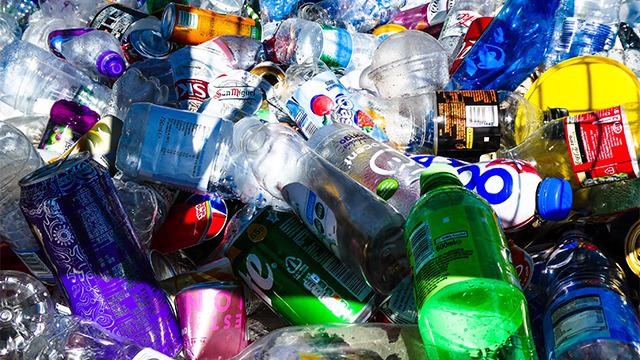In the United States, less than 10% of the 380 million metric tons of plastic generated yearly is recycled, posing a global environmental danger due to plastic manufacture and the annual absorption of millions of tons of garbage into bodies of water. When it comes to polymers, such as polyester, the proportion drops.
 The research will have implications in waste reduction as a more efficient way to break down polyesters. Image credit: Unsplash.
The research will have implications in waste reduction as a more efficient way to break down polyesters. Image credit: Unsplash.
Scientists have searched for alternate ways to decrease plastic waste rather than renewing their commitment to recycling processes that could only be used once on particular polymers. Plastic upcycling, or the process of deconstructing and recreating polymers, the fundamental building elements of plastic, has become a major area of interest.
We don’t need to make more. You can reuse the ones already here to make an equally good plastic—or better.
Monica Olvera de la Cruz, Study Senior Author, Northwestern University
Now, a team led by Northwestern University has developed a technique to improve the impacts of such an enzyme that breaks down polyester — the plastic used to make soda bottles and low-cost clothing (and commercially known as PET) — into its constituent parts, a breakthrough that could aid engineers in formulating solutions for removing microplastics from rivers and oceans.
Their results, which will be published in the journal Proceedings of the National Academy of Sciences (PNAS) on March 21th, 2022, will help to advance biotechnology, bioremediation and medicine.
Monica Olvera de la Cruz of Northwestern University, the paper’s principal author, noted that in regeneration, plastic is heated, broken down and then reconstructed into weaker, lower-quality polymers. However, with upcycling, breaking down polymers into their essential components can occasionally result in even more durable plastics than before.
Olvera de la Cruz’s team aimed to establish a green upcycling technique that did not generate pollution but instead eliminated it. The researchers established a procedure that can be reproduced without the need for additional solvents by employing an enzyme that could be generated in the lab.
People have discovered an enzyme—bacteria that eats polyester to survive and converts it into monomeric units. But they haven’t been able to use it because it breaks down at a certain temperature. Our idea was to build polymers capable of encapsulating the enzyme to protect its structure so that it can continue to function outside of living cells and in the lab at sufficiently high temperatures to be able to break down PET.
Monica Olvera de la Cruz, Study Senior Author, Northwestern University
The researchers created polymers and the conditions required to successfully preserve the enzyme (named PETase) so that it would not unravel and become useless when the structure was heated. The polymer is made up of a hydrophobic (water-repellent) backbone and exact concentrations of its three components predicted by first author and Ph.D. scholar Curt Waltmann to interface with active sites on the enzyme.
Waltmann discovered that if the polymer had too much negative charge, the enzyme would dissolve in water and the polymer would not cover enough of the enzyme’s surface to protect it.
The polymer was combined with chemically generated enzymes after being manufactured using a technique known as free radical polymerization, which quickly binds monomers together.
We found that if you put the complex of the polymer with the enzyme together, and close to plastic, and then you heat it slightly, the enzyme was able to break it down into small, monomeric units. In addition to operating in an environment like where it could clean microplastics, our method has protected against high-temperature degradation, and one student was able to do the testing.
Monica Olvera de la Cruz, Study Senior Author, Northwestern University
The scientists opened several opportunities for the scientific community by discovering a mechanism to safeguard the enzyme from heat. The team’s goal is to encapsulate whole microplastics in the structure, then use these enzymes to create a microplastic aggregate.
The US Department of Energy has launched a program to finance polymer upcycling initiatives that would help reduce the use of plastic, and Olvera de la Cruz believes her project will help advance the mission.
Olvera de la Cruz added, “You can make a new polymer with the monomeric units. These are dangerous things that are bad for our health. We don’t need to make more. You can reuse the ones already here to make an equally good plastic—or better.”
Lawyer Taylor, Professor of Materials Science and Engineering, Chemistry and Chemical and Biological Engineering, Physics and Astronomy, and Director of the Center for Computation and Theory of Soft Materials, Olvera de la Cruz, Carolyn Mills, Jeremy Wang, Baofu Qiao, John Torkelson, and Danielle Tullman-Ercek are among the Northwestern researchers who have worked with Olvera de la Cruz and Waltmann.
The US Department of Energy’s Office of Basic Energy Sciences funded the publication “Functional Enzyme-Polymer Complexes” (Contract DE-FG02-08ER46539).
Journal Reference:
Waltmann, C., et al. (2022) Functional enzyme–polymer complexes. Proceedings of the National Academy of Sciences. doi.org/10.1073/pnas.2119509119.